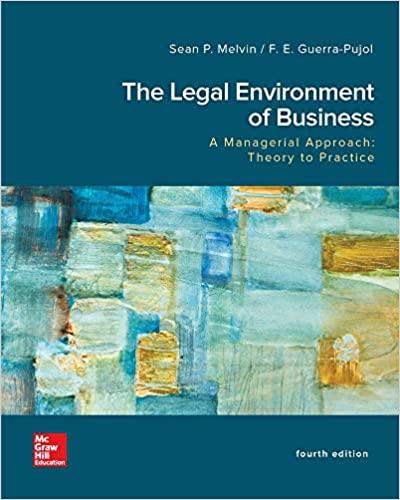Question
Case: Cassidy v. Detroit Edison Company 138 F.3d 629 (6th Cir. 1997) The employee, Cassidy, began suffering allergic reactions to workplace substances after exposure to
Case: Cassidy v. Detroit Edison Company 138 F.3d 629 (6th Cir. 1997)
The employee, Cassidy, began suffering allergic reactions to workplace substances after exposure to "stack gas." Over a period of time, the employer attempted accommodations that proved ineffective. The employee was eventually terminated, and she sued under the ADA. The court had to determine whether the employer had reasonably accommodated the employee and found that the employer had done so.
Suhrheinrich, J.
Cassidy worked as an assistant power plant operator at Detroit Edison Company (DEC) until she was exposed to "stack gas" on the job. As a result, she suffered numerous allergic reactions to a multitude of substances. To accommodate her breathing and allergy conditions, the company found an assignment for her in the area with the most filtered and clean air, the computer center. After a time, Cassidy experienced more breathing difficulties from exposure in her work environment to cleaning chemicals, diesel fumes, food odors, paint fumes, and smoke. DEC accommodated her by scheduling her for straight day shifts, allowing her to leave when a known allergen would be present, testing the area to comply with environmental air standards, permitting her to wear a mask and use a breathing machine, and scheduling maintenance when she was not present. DEC also tested its facilities for fungus, bacteria, and mists to find an adequate work environment for her.
Still having breathing problems, Cassidy met with several of her doctors. . .. An independent medical examiner examined Cassidy and recommended: "a location that is reasonably free of irritants and also an area where she may have some control over the environment through use of desktop air purifiers."
During this time, Defendant's staff continued to assess available positions within the company to accommodate Plaintiff. . .. Upon finding no position available at the company with these restrictions, the company terminated her. Cassidy filed suit, alleging that her termination violated the ADA because the employer had failed to reasonably accommodate her disability. The district court found no genuine issue of material fact, that "[DEC] did all that it possibly could to accommodate [Cassidy] in light of her disability," and granted DEC's motion for summary judgment. Cassidy appealed.
Under the ADA, an employer need only reassign the employee to a vacant position. Generally, transfer or reassignment of an employee is only considered when accommodation within the individual's current position would pose an undue hardship. An employer may reassign an employee to a lower grade and paid position if the employee cannot be accommodated in the current position and a comparable position is not available. However, a reassignment will not require creating a new job, moving another employee, promoting the disabled employee, or violating another employee's rights under a collective bargaining agreement.
The employer provided several reasonable accommodations, including initially transferring Plaintiff to the computer department after her first asthmatic attack; allowing Plaintiff to work straight days; scheduling cleaning and maintenance to occur when Plaintiff was gone; allowing Plaintiff to leave when she may be exposed to allergens; allowing Plaintiff to use her prescribed breathing apparatus at work; allowing Plaintiff to use paid and unpaid leave, and testing Plaintiff 's work area. The district court noted that based on her physicians' vague recommendations, Plaintiff requested transfers to a vacant position in a well-ventilated and allergen-free workstation that would not "trigger asthma or cause a drop in peak flow." But because Plaintiff did not "identify the precise limitations resulting from the disability and potential reasonable accommodations that could overcome those limitations," the district court concluded that "Defendant did all that it possibly could to accommodate Plaintiff in light of her disability."
We agree with the district court. Plaintiff 's proposed accommodation for essentially an allergen-free workplace, which Defendant attempted to locate within the company, was simply too vague to reasonably inform Defendant of reasonable accommodation or was otherwise simply unavailable. Defendant attempted numerous accommodations but finally concluded that there was no sufficiently allergen-free work environment within the company in which Plaintiff could perform her job. Plaintiff had the duty to propose an objectively reasonable accommodation. However, Plaintiff simply failed to make a genuine issue of material fact as to Defendant's assertions that no such allergen-free work environment existed within the company for Plaintiff. Further, Plaintiff also did not demonstrate that there were any vacant positions in such areas.
Thus, based on Plaintiff 's lack of specific proposed accommodation, Defendant's previous attempts to accommodate Plaintiff, and Defendant's conclusion that it did not have a position in the company that satisfied Plaintiff 's vague restrictions, there is no genuine issue of material fact that Plaintiff failed to propose or identify an objectively reasonable accommodation. Therefore, Defendant is entitled to judgment as a matter of law.
Answer by:
- fact
- issues
- analysis
- decisions
Step by Step Solution
There are 3 Steps involved in it
Step: 1

Get Instant Access to Expert-Tailored Solutions
See step-by-step solutions with expert insights and AI powered tools for academic success
Step: 2

Step: 3

Ace Your Homework with AI
Get the answers you need in no time with our AI-driven, step-by-step assistance
Get Started


